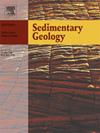Diverse origins and depositional patterns of phytoclast tufas in the Lower Cretaceous Jinju Formation, southern Korea
IF 2.9
2区 地球科学
Q1 GEOLOGY
引用次数: 0
Abstract
Phytoclast tufas, allochthonous plant fragments encrusted by freshwater calcium carbonates, hold valuable clues to past environments and ecosystems. While these structures have been documented in various settings throughout geological time, detailed studies on the formative processes and paleoenvironmental implications of fossil phytoclast tufas, particularly in the Mesozoic, are scarce. This study investigates phytoclast tufas from the Lower Cretaceous Jinju Formation in the Gyeongsang Basin, southern Korea, to characterize their depositional patterns and paleoenvironmental context. Through the integration of macroscopic observations and detailed microfacies analysis, complemented by elemental composition measurements, we reveal a complex interplay of biological and abiotic factors in the formation of phytoclast tufas. Our findings highlight distinct differences in microfabrics and depositional patterns among phytoclast tufas from three localities (Geobuk-gil, Yonggung-ro, and Seonjeon-ri), despite their similar macrostructures. In the Geobuk-gil section, phytoclast tufas likely formed through microbial influence in paludal (marsh-like) setting and were deposited in the lake center. The Yonggung-ro phytoclast tufas presumably developed in a barrage system with both microbial and abiotic precipitation inducing tufa formation, and were transported to the lake margin and deposited by waves, resulting in fragmentation. In the Seonjeon-ri section, the phytoclast tufas may have formed in an abiotic precipitation-dominant lake margin environment and were subsequently transported by debris flows and deposited as a fan. These discrete phytoclast tufa horizons may represent episodic climatic events within the predominantly clastic succession. By demonstrating the diverse origins and depositional environments of phytoclast tufas within the same stratigraphic unit, our study contributes to refining models of tufa formation and underscores the importance of detailed microfacies analysis in paleoenvironmental reconstructions.
韩国南部下白垩统晋州组植物碎屑凝灰岩的不同成因和沉积模式
被淡水碳酸钙包裹的外来植物碎片凝灰岩为过去的环境和生态系统提供了有价值的线索。虽然这些结构在整个地质时期的不同背景下都有记录,但对植物碎屑凝灰岩化石的形成过程和古环境意义的详细研究,特别是在中生代,还很少。本文对韩国庆尚盆地下白垩统晋州组植物碎屑凝灰岩进行了研究,探讨了其沉积模式和古环境背景。通过宏观观察和详细的微相分析,并辅以元素组成测量,我们揭示了生物和非生物因素在植物碎屑凝灰岩形成过程中的复杂相互作用。我们的研究结果强调了三个地点(Geobuk-gil, yonggong -ro和Seonjeon-ri)的植物碎屑凝灰岩的微结构和沉积模式的明显差异,尽管它们的宏观结构相似。在巨北-吉尔剖面,植物碎屑凝灰岩可能是在古陆(沼泽样)环境中受到微生物的影响而形成的,并沉积在湖中心。yonggong -ro植物碎屑凝灰岩可能是在微生物和非生物降水共同作用下形成的拦河坝系统中形成的,并被海浪搬运到湖缘沉积,造成碎裂。在仙田里剖面,植物碎屑凝灰岩可能形成于以非生物降水为主的湖缘环境,随后被泥石流搬运并形成扇状沉积。这些离散的植物碎屑凝灰岩层可能代表了主要碎屑演替中的偶发性气候事件。通过展示同一地层单元内植物碎屑凝灰岩的不同起源和沉积环境,我们的研究有助于完善凝灰岩形成模型,并强调了详细的微相分析在古环境重建中的重要性。
本文章由计算机程序翻译,如有差异,请以英文原文为准。
求助全文
约1分钟内获得全文
求助全文
来源期刊

Sedimentary Geology
地学-地质学
CiteScore
5.10
自引率
7.10%
发文量
133
审稿时长
32 days
期刊介绍:
Sedimentary Geology is a journal that rapidly publishes high quality, original research and review papers that cover all aspects of sediments and sedimentary rocks at all spatial and temporal scales. Submitted papers must make a significant contribution to the field of study and must place the research in a broad context, so that it is of interest to the diverse, international readership of the journal. Papers that are largely descriptive in nature, of limited scope or local geographical significance, or based on limited data will not be considered for publication.
 求助内容:
求助内容: 应助结果提醒方式:
应助结果提醒方式:


